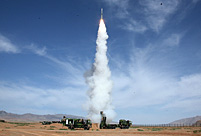 |
| (file photo) |
The Three Pagodas are located about 1.5 km to the north of scenic Dali, Yunnan province. They are at the east foot of the tenth peak of the massive Cangshan Mountains and face the west shore of the Erhai Lake of the ancient Dali town. It is a symbol of the history of Dali City, and a record of the development of Buddhism in the area. In 1981, Chongsheng Temple was granted to be the key protection unit of historical relics of China.
Chongsheng Temple was originally built during the Kaiyuan reign of Tang Dynasty (713-741AD). It was a famous royal monastery for the consecutive Nanzhao Kingdom and Dali Kingdom. A total of nine kings of Dali Kingdom abandoned worldly life and studied Buddhism here.
At its prime time, the temple had890 rooms, 11,400 bronze statues made of over 20,000 km of bronze at the cost of 700,000 man-days. Between the Tang Dynasty and the Ming Dynasty, Chongsheng Temple had five important implements: Three Pagodas, Big Jianji Bell, Bronze Rain Statue of the Goddess of Mercy, the Yuan horizontal board inscribed with "Capital of Buddhism". and the Ming gold statue of "Three Saints".
Xu Xiake recorded the grandeur and magnificence of this temple in his Travelogue when he visited Dali during the late Ming Dynasty. He wrote: "The three pagodas stand like a tripod: the Bronze Rain Statue of the Goddess of Mercy is as tall as three zhang the Big Jianji Bell is especially large and over one zhang in diameter and one chi in thickness,and its sound can be heard 80 li away."
During the one thousand years since the Three Pagodas were built, they have gone through war and earthquakes. They have been repaired numerous times. There was a severe earthquake in the Dali area in 1925. Few buildings in Dali survived, but the Three Pagodas were undamaged
The Three Pagodas are made of brick and covered with white mud. As its name implies, the Three Pagodas comprise three independent pagodas forming a symmetric triangle. The main pagoda, known as Qianxun Pagoda (pinyin Qian Xun Ta), reportedly built during 823-840 AD by king Quan Fengyou of the Nanzhao state, is 69.6 meters (227 feet) high and is one of the tallest pagodas in China’s history.]The central pagoda is square shaped and composed of sixteen stories; each story has multiple tiers of upturned eaves. There is a carved shrine containing a white marble sitting Buddha statue at the center of each façade of every story. The body of the pagoda is hollow from the first to the eighth story, surrounded with 3.3 meters (10 feet) thick walls. The other two sibling pagodas, built about one hundred years later, stand to the northwest and southwest of Qianxun Pagoda. They are 42.19 meters (140 feet) high. Different from Qianxun Pagoda, they are solid and octagonal with ten stories. The center of each side of every story is decorated with a shrine containing a Buddha statue.
The cultural-oriented tourism zone of Chongsheng Temple and Three Pagodas embodies an integration of mountain and sea scenery, historical relics, Buddhist culture, and leisure & vacationing function. As sacred buildings in ancient times, pagodas mainly have the following functions: First, as a landmark. Second, for storage purposes; in some Buddhist temples, pagodas are be used to store Buddhist scriptures and to keep Buddha's relics. Third, for Fengshui enhancement; pagodas are built to wall off evil forces and to enhance Fengshui.
During the renovation in 1979, more than 600 pieces of cultural relics were discovered, including hand-written Buddhist scriptures, books, engraved bronze plates, bronze mirrors, statues of Buddha made of gold, silver, bronze, iron, porcelain, jade, and quartz, and medicinal herbs. Up to now, they constitute the largest store of relics of Nanshao and Dali Kingdoms ever found, providing sure proofs of the influence of the Han culture upon minority nationalities in the border areas.
Today, travelers can visit Three Pagodas at night, when it is illuminated providing a fantastic scene. Nearby on the "marble street" there are many folk-craft workshops and stands specializing in marble and brick-painting.
Opening Hours: 8:00 a.m.- 7:00 p.m.
Admission Fee: CNY 120
Recommended Time for a Visit: Two hours
Address: about 1 kilometer (0.6 mile) to the northwest of the ancient city of Dali.
 National Plug In Day celebrated in Washington D.C.
National Plug In Day celebrated in Washington D.C. New model of indigenous surface-to-air missiles testfired
New model of indigenous surface-to-air missiles testfired  118.28-carat diamond to be auctioned in HK
118.28-carat diamond to be auctioned in HK Maternal love under streetlight
Maternal love under streetlight Naked foreign student sits in the middle of a road in Haikou
Naked foreign student sits in the middle of a road in Haikou  Colorful Yunnan: Enjoy the natural beauty
Colorful Yunnan: Enjoy the natural beauty Harbin named Chinese city with most beautiful women
Harbin named Chinese city with most beautiful women For last four students, teacher couple sticks to post on island
For last four students, teacher couple sticks to post on island  When big sport stars were kids
When big sport stars were kids PLA's 38th Group Army conduct training
PLA's 38th Group Army conduct training People mourn for victims of mall attack
People mourn for victims of mall attack The last days of Wan Aihua
The last days of Wan Aihua Highlights at 12th National Games of China
Highlights at 12th National Games of China Beijing Film Academy welcomes freshmen
Beijing Film Academy welcomes freshmen Large mahjong party sets new world record
Large mahjong party sets new world recordDay|Week|Month